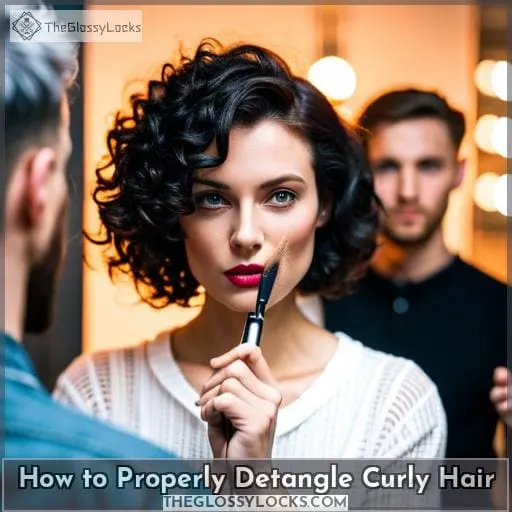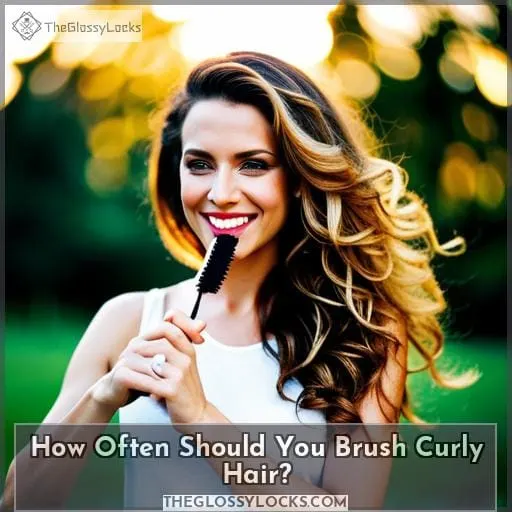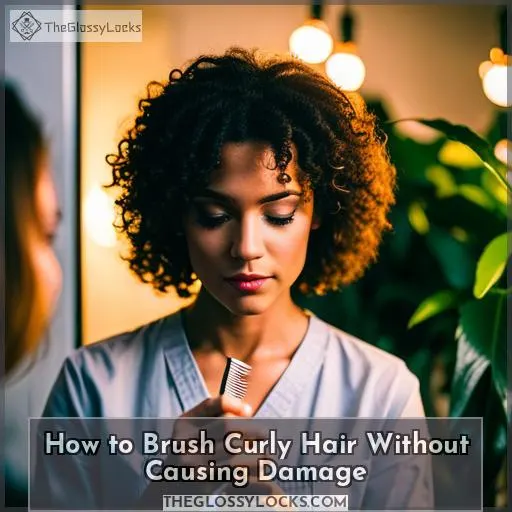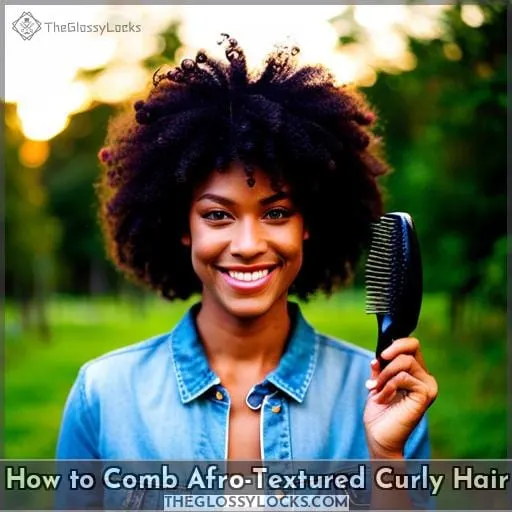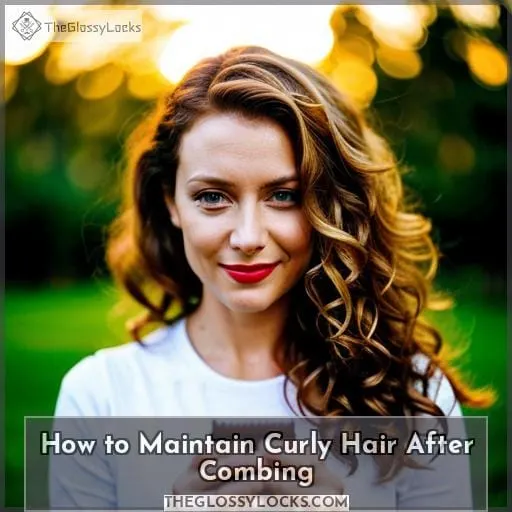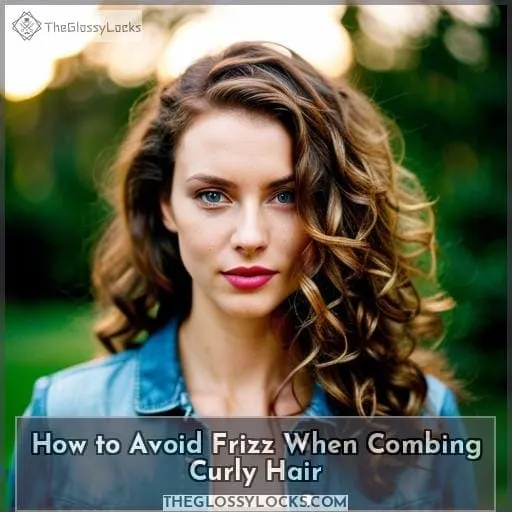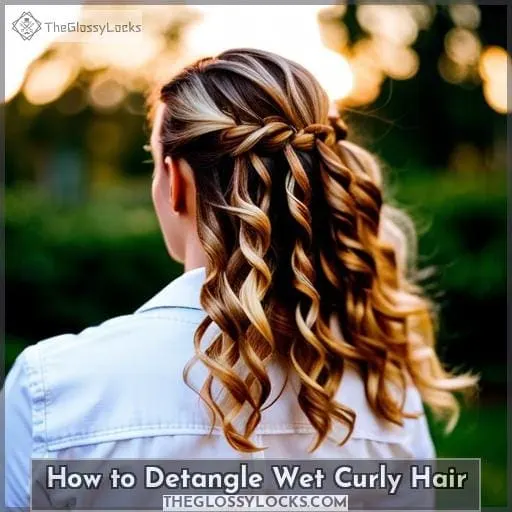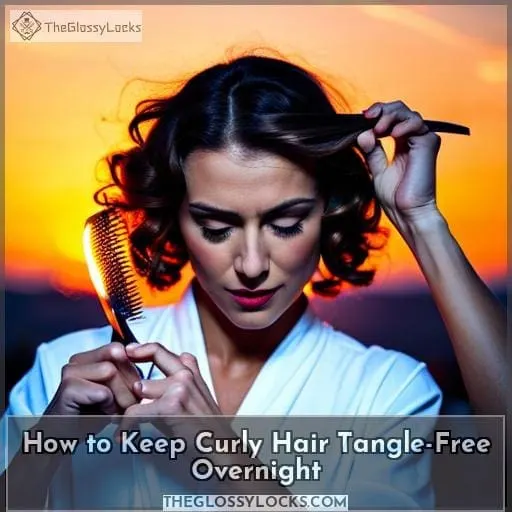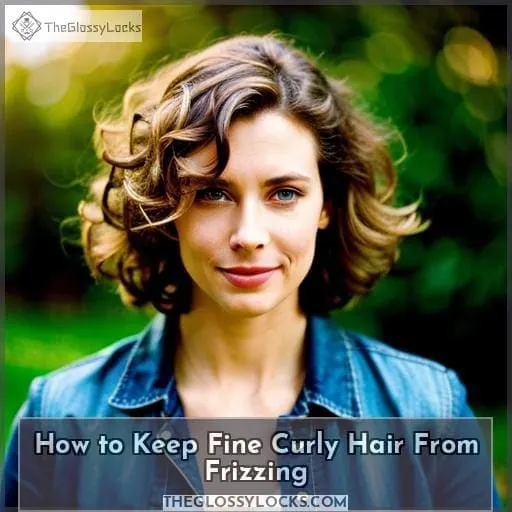This site is supported by our readers. We may earn a commission, at no cost to you, if you purchase through links.
Are you tired of struggling with your curly hair? It can be difficult to manage and maintain, but it doesn’t have to be! With the right methods and tools, you can learn how to comb curly hair without causing frizz or damage.
In this article, we’ll show you everything from choosing the right brush for your locks, detangling properly, preventing frizz when combing wet curls, as well as maintaining them overnight.
Table Of Contents
- Key Takeaways
- How to Choose the Right Brush for Curly Hair
- How to Properly Detangle Curly Hair
- How Often Should You Brush Curly Hair?
- How to Brush Curly Hair Without Causing Damage
- How to Comb Afro-Textured Curly Hair
- How to Maintain Curly Hair After Combing
- How to Avoid Frizz When Combing Curly Hair
- How to Detangle Wet Curly Hair
- How to Keep Curly Hair Tangle-Free Overnight
- How to Keep Fine Curly Hair From Frizzing
- Frequently Asked Questions (FAQs)
- What products can I use to keep my curly hair hydrated?
- How can I prevent static when combing curly hair?
- What is the best way to detangle curly hair without causing damage?
- What is the best way to maintain curly hair after brushing or combing?
- How can I prevent frizz when brushing or combing my curly hair?
- Conclusion
Key Takeaways
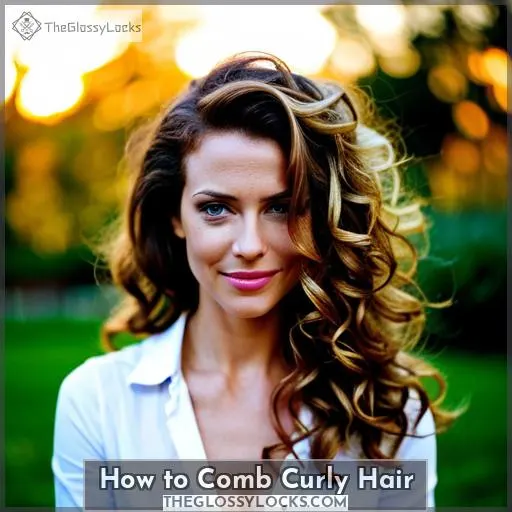
- Use the right tools, such as wide-toothed combs and detangler brushes, to gently detangle curly hair.
- Apply hydrating products, like leave-in conditioner or natural oils, to make detangling easier and prevent damage or frizz.
- Section off hair into quarters and start detangling from ends to roots for even and effective styling.
- Avoid overbrushing, using too much heat or chemical treatments, and rubbing/twisting hair with a towel turban after washing to prevent damage and maintain healthy curls.
How to Choose the Right Brush for Curly Hair
You need to choose the right brush for your curly hair if you want to maintain its health and shape. A good grip on the handle is important, as well as boar or nylon bristles that are widely spaced. Scalp massaging balls should be avoided. When selecting a brush for wet detangling, it’s best to go with one designed specifically for textured and curly hair types.
Heat avoidance is key when brushing this type of hair, so look out for brushes that advertise being safe for wet strands. Wider bristle brushes may work better on tighter curls, whereas dense ones help separate looser curls.
How to Properly Detangle Curly Hair
Detangling curly hair can be a tricky process, but with the right tools and techniques, you’ll find it much simpler. Start by using a wide-toothed comb to gently ease through knots without pulling or breaking your strands.
Treating your hair with hydrating products helps make detangling easier, as does wetting your curls before working them out.
Using a Wide-Toothed Comb
Using a wide-toothed comb is often thought to be the best way to untangle curly hair without causing frizz, but research suggests this isn’t necessarily true. Conditioner and styling foam should be applied before using a microfiber cloth or cotton t-shirt for detangling.
Nick Arrojo recommends using the Best Hair Brush for two-strand twist outs with dense boar bristles that won’t pull at your curls.
To pat down damp strands, a microfiber towel is ideal, and an edge gel can help control flyaways while brushing spirals from roots to ends without tugging or shedding.
Treating Hair With Products
Before brushing or combing your curly hair, treat it with products like dry shampoo, detangling spray, coconut oil, and olive oil. Use a bit of edge gel to define baby hairs for extra definition. Add volumizing spray to keep flyaways in check.
When wetting hair, be sure to use a detangling brush so as not to break the strands when pulling through knots and tangles.
With these tips, your locks should look healthier than ever before without sacrificing their bounce and curl pattern!
Wetting Hair
When wetting your wavy tresses, use a detangling brush to avoid breaking strands while pulling through knots and tangles.
- Start by applying products like dry shampoo or leave-in conditioners before wetting hair.
- Divide the hair into four sections using clips and start with one section at a time when brushing out the curls.
- Opt for boar bristle brushes or wide-tooth combs instead of paddle brushes to prevent excess heat damage from occurring on curly hair textures.
- Avoid using too many chemical treatments, alcohol-containing hairsprays, and towels, which can cause frizzing of the locks when drying them off after washing them.
Be sure to keep an eye out for well-known icons’ favorite styling techniques, such as proper brushing of curly hair with oils and creams that will give you extra definition throughout your mane!
Sectioning Hair
Divide your hair into four sections to make brushing and combing easier. Use clips or a headband to keep each section in place. Prior to combing, treat your hair with products like dry shampoo, detangling spray, coconut oil, or olive oil for better results.
It’s essential to have a good grip on the brush for heat protection and recognized razor-cutting technique. Use edge gel on baby hairs as well. The best brushes have wider spaced bristles that are suitable for all curl patterns, while nylon/boar bristles work best on textured/curly tresses respectively.
How Often Should You Brush Curly Hair?
You don’t have to brush your curly hair every day; frequency is key for maintaining the integrity of your curls. Regular upkeep of wavy hair with precision-based hairdressing methods and years of experience can make a huge difference in keeping it healthy and strong.
When brushing, opt for different methods instead of using heat or chemical treatments as these tend to damage the strands more than they help. Instead, use products like leave-in conditioner or moisturizing cream before you start detangling.
When selecting a comb type, choose one that has wider spaced bristles so it’s easier to work through tangles without tugging too hard on strands. Boar bristle brushes are ideal here due to their softness yet firm grip when used correctly! Additionally, consider getting a haircut from someone experienced in cutting curly hair since this will keep bulkiness at bay after brushing sessions take place regularly enough.
To ensure maximum hydration levels while brushing out those lustrous locks, be sure to apply some kind of oil serum beforehand. This will prevent static electricity buildup which leads to frizzy flyaways no matter how much effort was put into styling them otherwise! Finally, volumizing spray might come in handy during regular upkeep sessions if desired volume was not achieved by simply combing alone.
How to Brush Curly Hair Without Causing Damage
Brushing curly hair can be tricky, but with the right techniques and products, you can keep it looking healthy and beautiful. Hydration is key when trying to maintain curls without causing damage. Use a brush that won’t pull or snag, make sure to keep your hair well moisturized with leave-in conditioner or cream, and take care not to overbrush.
Brushing Techniques
Take the time to master your brushing technique for beautiful, healthy curls! Start by selecting a brush best suited to your texture and hair type. Boar or nylon bristles are ideal for textured and curly strands. Wider spaces between the teeth work well at detangling without causing damage or frizz.
Avoid brushes with scalp massaging balls as they can pull too hard on delicate curls.
When wet, use fingers instead of a brush if you’re having a hard time getting through tangles – this is also great for baby hairs! Use leave-in conditioner before brushing dry hair and add volumizing spray afterwards to control flyaways.
It’s all about hydration when caring for curly locks, so decide what works best depending on styling goals.
Hydration and Moisture
Hydrate your curls with leave-in conditioner and moisturizing cream to keep them lush and vibrant! Use hydrating products such as black vanilla moisture shine leave-in conditioner or natural oils like coconut, avocado, and argan for maximum hydration.
Proper combing is also important. Use a brush with boar bristles or scalp massaging balls for optimal results.
Include a wide range of brushes in your routine. Wider spaced bristles help detangle while denser ones separate looser curls.
Using the Right Brush
Choose a brush or comb that best suits your hair type and thickness to ensure you’re getting the most out of your detangling routine. Consider the different brushes available, from boar bristles to nylon. Carefully choose one with enough grip for thick curls in need of more structure.
For looser coils, opt for wider spaced bristles which will help define each curl without tugging too hard on delicate strands like baby hairs.
Wooden combs are great options if static is an issue. Volumizing sprays can lend hold and control flyaways as you work through spirals. Heat avoidance is key. Use sulfate-free shampoo when washing curly hair and keep it hydrated before brushing with hydrating oils or serums.
Using Leave-in Conditioner or Moisturizing Cream
For the best results, treat your curls to a leave-in conditioner or moisturizing cream before combing – it’ll be like night and day! Using products such as these can provide heat protection for hair types that are prone to damage.
Wetting hair is not always necessary; rather, opt for using the right product at the right time. A good choice is a volumizing spray prior to brushing lower sections of curly hair with soft bristles.
It’s important to select one tailored specifically for textured or curly locks in order to keep integrity intact while avoiding frizziness.
How to Comb Afro-Textured Curly Hair
Gently detangling your afro-textured curls with a wide-toothed comb is essential to keep them healthy and strong. To achieve beautiful, frizz-free curls, you’ll need deep conditioning treatments that add moisture to the hair, an understanding of your unique hair texture, and an arsenal of natural oils and edge control products for styling.
When it comes to choosing the right brush or comb, consider the handle design as well as the bristles. Boar bristle brushes are best for textured and curly hair because they have widely spaced bristles that work great at detangling without causing too much pulling or tugging of strands.
They also come with scalp massaging balls that help stimulate circulation to promote healthy growth and decrease split ends over time.
For looser curl patterns, go for dense brushes like Denman ones instead. These will separate out those bigger coils better when applied correctly alongside some heat tools such as curling wands or flat irons.
Finally, make sure you get a great haircut done by someone experienced in cutting curly locks so that your style won’t feel bulky afterwards. Considering all this advice should ensure optimal results every single time! In addition, avoid using towels (which can add frizz), too much heat through chemical treatments/hairsprays containing alcohols (as these could cause damage).
Use water spritzers/cotton t-shirts/microfiber cloths instead along with dry shampoo & conditioner plus coconut oil & olive oil before starting up on any kind of brushing routine.
How to Maintain Curly Hair After Combing
Maintaining curly hair after combing can be a challenge, but with the right tips and techniques, you can achieve great results! Start by using dry shampoo to keep your curls hydrated between washes. Choose the right brush or comb for your particular type of curl, avoid heat and chemical treatments as much as possible, and get a great haircut that works with your natural curl pattern rather than against it.
With these simple steps, you’ll be well on your way to having gorgeous curly locks.
Using Dry Shampoo
Try using dry shampoo to keep your curls feeling fresh and bouncy! It’s important to avoid heat, chemical treatments, and hair sprays that contain alcohol. Wooden combs are more gentle than those made of synthetic materials, and they don’t generate static like paddle brushes do.
After washing, use a dry conditioner for tighter textures or when you need extra hydration on dry curls. To maintain definition in the curl pattern without frizzing up the hair, use wooden combs instead of plastic ones with wider teeth.
The coarser material of plastic combs can snag finer strands or create split ends.
Using wooden combs will help add volume while keeping your curly mane balanced and healthy!
Choosing the Right Brush or Comb
To ensure that your hair is detangled without tugging or pulling, it is important to choose the perfect brush or comb for your hair type and thickness. Boar bristles are ideal for textured curls, while nylon is best for defining looser waves.
For extra thick hair, wider spaced combs with wooden teeth are recommended as they help control moisture levels and prevent excessive heat damage.
Avoiding Heat and Chemical Treatments
To protect your curls from damage, avoid using too much heat or chemical treatments on them. It’s important to get a great haircut to maintain the integrity of your curls and use only time-tested products for better control.
Dry shampoo is an excellent choice as it helps keep hair clean without having to apply water, which can create a frizz-filled look.
Getting a Great Haircut
Getting the perfect haircut for your curls is essential in maintaining their integrity – and it’s surprisingly easier than you might think!
To keep them looking healthy, use dry shampoo to clean out product build-up between washes. Avoid too much heat or chemical treatments that may damage hair. Choose brushes with wider spaced bristles for detangling and defining curls while avoiding scalp massaging balls on the brush.
A good haircut from an experienced stylist can make a world of difference when it comes to afro-textured hair.
Applying products correctly after haircuts, such as mousse, then curl crème or leave-in conditioner, will also help maintain healthier-looking locks!
How to Avoid Frizz When Combing Curly Hair
Avoiding frizz when styling curly hair can be tricky, but with the right products and expert tips, you can have lush curls that stay put. Using quality products is crucial to avoiding frizz. Dry shampoo, leave-in conditioner, curl defining cream, or even coconut oil can make a huge difference in keeping your locks looking their best.
Wetting your hair should only be done as an absolute last resort, and heat avoidance goes without saying! Regular trims are also essential for better results. Well-taken care of ends make all the difference in preventing split hairs from becoming more noticeable due to tangling or snagging on other strands of hair during brushing or combing sessions.
The type of brush used also matters. Wider spaced bristles are recommended for detangling without causing too much damage, while denser brushes work better with looser curls because they help define each ringlet more clearly than just using fingers alone would achieve! For tighter coils, try something like boar bristle brushes, which will reduce static and distribute oils evenly throughout the scalp and down the length.
When combing through curly hair, always start at the bottom near the tips first before progressing upwards towards the roots to avoid tugging at delicate areas near the scalp that might lead to additional fraying over time.
This slow process may take longer initially; however, consistent upkeep ensures a healthier overall look plus sustained definition between washes too. There’s no need to worry about crunchy texture either since volumizing sprays provide hold control flyaways after the initial styling session has been completed successfully (no towel turban twisting involved!).
With these helpful hints, there’s no excuse not to get the perfect ‘do every single time.
How to Detangle Wet Curly Hair
If you have curly or wavy hair, it is important to learn how to properly detangle it when wet. To do so effectively without damaging your strands, use a wide-toothed comb and a detangling brush. Avoid ripping or pulling on the hair while brushing, as this can cause breakage.
Instead, move slowly through the knots with delicate strokes. Additionally, avoid rubbing or twisting your curls into a towel turban after washing as this can create tangles that are difficult to undo later on.
Using a Detangler Brush
Using a detangler brush is key to brushing your curls without causing frizz and breakage. It’s important to use products like dry shampoo, wet hair carefully, section into four quarters, and choose brushes suitable for thickness.
A big difference can be made by using a detangler brush – it’s largely about preference! To ensure maximum health of your locks, avoid heat styling or chemical treatments that contain alcohol.
The best tips for caring for curly hair include: using enough product at the right time, leaving in braids overnight, investing in wooden combs instead of plastic ones to reduce static charge, and applying conditioner before combing through spirals straight after adding products.
Avoiding Ripping or Pulling Hair
It’s important to never pull or force the brush through your hair, as this can result in splits and hair loss. Use a wide-toothed comb with sturdy teeth for best results when detangling curly strands. Treating your locks with products like dry shampoo, detangling spray, coconut oil, or olive oil prior to combing will also help prevent major damage.
Choose a brush or comb based on the little space between bristles and type of curls. Wetting hair is only necessary if you find it painful otherwise. Applying conditioner before running through coils helps too! Avoid overusing heat tools and chemical treatments, which can cause breakage.
Avoiding Rubbing or Twisting Hair Into a Towel Turban
You should never rub or twist your hair into a towel turban, as it can add frizz and cause splits. Leaving in conditioner before combing is essential to help detangle curls while avoiding damage. Heat avoidance is also key for healthy curls. Use oil-based styling products like coconut or olive oil instead of chemical treatments and hairsprays that contain alcohol.
Choose the right type of comb too. Wide-toothed combs are best for textured hair, while denser brushes work better on looser curls.
How to Keep Curly Hair Tangle-Free Overnight
To keep your tresses looking their best, try using a leave-in conditioner and protective hairstyle overnight for tangle-free curls in the morning. An effective way to do this is by braiding your hair into several sections with loose plaits or twists.
This will help prevent knots from forming while you sleep and make it easier to detangle in the morning.
Additionally, applying styling products such as volumizing sprays can also provide extra hold that can help maintain healthy curls throughout the night without causing damage or frizziness when you wake up.
Wooden combs are great tools for combing out any remaining tangles before bedtime as they don’t generate static like plastic ones may tend to do, so they won’t tug on delicate strands of hair when used correctly.
Leave-in conditioners are good too because they add moisture back into curly locks after being washed, which prevents them from drying out during sleep and becoming brittle over time – just be sure not to apply too much! Finally, never forget about taking care of those baby hairs around edges; use a hydrating edge gel made specifically for textured hair along with some light brushing down every few days if needed (but avoid doing this every day).
With these tips combined together, there’s no doubt that your curl pattern will stay soft yet defined all day long!
How to Keep Fine Curly Hair From Frizzing
By taking the proper steps before brushing, such as adding moisture and detangling thoroughly, you can help keep fine curly hair from frizzing by giving each coil more definition. Using products specifically designed for textured hair is key to making sure your curls look their best.
Start with a volumizing foam or mousse first and then apply a curl crème or leave-in conditioner for extra hydration that will lock in moisture.
When it comes to choosing brushes and combs, there is no one-size-fits-all approach, so make sure you pick one according to the thickness of your tresses. Wider spaced bristles work better when detangling, while dense ones separate loose curls nicely.
Wood combs may be better than plastic if static tends to be an issue, but ultimately experiment until you find what works best for keeping flyaways under control without breaking up spirals once they have been formed after product application.
Heat protection should also not go amiss – blow-drying on a low heat setting only when necessary – since high temperatures often lead to coarse tendrils being damaged beyond repair over time, coupled with frequent trims at quality salons ensuring any split ends don’t travel further up the hair shaft!
Ultimately, with some care taken prior, combing out tangles becomes a much easier task, allowing 3C/4A kinks to finally take center stage free from unruly fuzziness while maintaining the integrity of coils left intact, ready to rock the world looking fabulous every day, regardless of the occasion!
Frequently Asked Questions (FAQs)
What products can I use to keep my curly hair hydrated?
The article has been read 101,707 times. To keep curly hair hydrated, use leave-in conditioner and moisturizing cream to help maintain curls. Consider using coconut or olive oil, detangling spray, dry shampoo, and/or bodybuilding foam for added definition.
How can I prevent static when combing curly hair?
To prevent static when combing curly hair, use a wooden comb with wide teeth to gently detangle. Smooth any stray hairs with an edge gel and volumizing spray for added hydration and control of flyaways.
What is the best way to detangle curly hair without causing damage?
Gently detangle curly hair with a wide-toothed comb and your fingers. Use hydrating products to loosen curls, avoid heat and chemical treatments, and apply enough product for your hair type. Keep frizz at bay by using dry shampoo or spritzing water on the ends of your hair.
What is the best way to maintain curly hair after brushing or combing?
To maintain healthy curls after brushing or combing, use a good brush, apply moisturizers and conditioners, avoid heat and chemicals, section your hair into four quarters for even detangling, and start from the ends to the root of each strand.
How can I prevent frizz when brushing or combing my curly hair?
To prevent frizz when brushing or combing your curly hair, use a wide-toothed comb with sturdy teeth. Treat your locks with products like dry shampoo and detangling spray before starting. Divide your hair into sections and work downward, gently teasing out knots from ends to roots.
Conclusion
With the right brush and technique, you can easily achieve beautiful, tangle-free curls. Make sure to use products that will keep your curls hydrated and protected. Comb and brush your hair with care, avoiding pulling and tugging.
Be gentle with your curly locks – your hair is like precious silk, so treat it as such! With these tips, you’ll be able to comb your hair and keep it looking fabulous in no time, with minimal effort.


